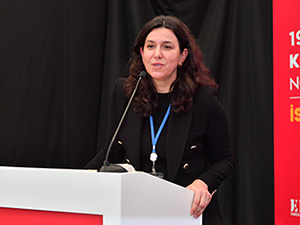Passenger Demand Recovery Continues in August
Geneva - The International Air Transport Association (IATA) announced that the strong post-pandemic passenger traffic trend continued in August.

05 Ekim 2023 Perşembe 08:34
• Total traffic in August 2023 (measured in revenue passenger kilometers or RPKs) rose 28.4% compared to August 2022. Globally, traffic is now at 95.7% of pre-COVID levels.
• Domestic traffic for August rose 25.4% versus August 2022 and was 9.2% above the August 2019 results. This is largely driven by Chinese domestic demand.
• International traffic climbed 30.4% compared to the same month a year ago. All markets saw double-digit percentage gains year on year. International RPKs reached 88.5% of August 2019 levels.
“Demand for air travel performed well in August. For the year to date, international traffic has increased by 50% versus last year and ticket sales data show international bookings strengthening for travel in the last part of the year,” said Willie Walsh, IATA’s Director General.
| ||||||||||||||||||||||||||||||||||||||||||||||||
1% of industry RPKs in 2022 2year-on-year change in load factor 3Load Factor Level |
International Passenger Markets
Asia-Pacific airlines saw a 98.5% increase in August 2023 traffic compared to August 2022, continuing to lead the regions. Capacity climbed 85.5% and the load factor increased by 5.5 percentage points to 84.2%.
European carriers’ August traffic rose 13.6% versus August 2022. Capacity increased 12.3%, and load factor edged up 1.1 percentage points to 86.8%.
Middle Eastern airlines posted a 27.3% increase in August traffic compared to a year ago. Capacity rose 22.7% and load factor climbed 3.0 percentage points to 83.1%.
North American carriers had an 18.6% traffic rise in August 2023 versus the 2022 period. Capacity increased 17.5%, and load factor improved 0.8 percentage points to 87.7%, which was the highest among the regions for a third consecutive month.
Latin American airlines’ traffic rose 26.4% compared to the same month in 2022. August capacity climbed 23.8% and load factor rose 1.7 percentage points to 86.1%.
African airlines saw a 26.1% traffic increase in August 2023 versus a year ago. August capacity was up 25.5% and load factor rose 0.4 percentage points to 76.2%.
| Domestic Passenger Markets | |||||||||||||||||||||||||||||||||||||||||||||||||
| |||||||||||||||||||||||||||||||||||||||||||||||||
1% of industry RPKs in 2022 2year-on-year change in load factor 3Load Factor Level |
Indian domestic RPKs rose 23.2% compared to a year ago and have now exceeded pre-pandemic levels for seven consecutive months.
Japan’s domestic market was impacted by Typhoon Khanun which caused major air traffic disruptions in southern Japan. Domestic RPKs grew 8.7% year over year, down on the 13.4% growth recorded in the previous month.
|
The Bottom Line
“Heading into the last quarter of the year, the airline industry is nearly fully recovered to 2019 levels of demand. The focus, however, has not been on getting back to a specific number of passengers or flights, but rather on meeting the demand by businesses and individuals for connectivity that was artificially suppressed for more than two years. Having seen the economic, social, and personal losses when airlines could not fly during the COVID-19 crisis, this industry is determined to secure a sustainable long-term future by achieving net zero carbon emissions by 2050. That was clearly evident at the first IATA World Sustainability Symposium where discussions focused on how to decarbonize. We know that our customers want a world in which they can enjoy the freedom to travel sustainably. This inaugural World Sustainability Symposium was a critical step in aligning policy makers, the aviation value chain and airlines with the concrete steps needed to deliver. And we will measure progress when we meet again in a year’s time,” said Walsh.
![2025 Atlas Lojistik Ödülleri’ni Kazananlar Ne Dediler? - Melike Batur]() 2025 Atlas Lojistik Ödülleri’ni Kazananlar Ne Dediler? - Melike Batur2025 Atlas Lojistik Ödülleri yarışmasında “En Beğenilen Depo Yöneticisi (Online Oylama)” ödülünü alan Melike Batur’un tören sonrasında kameralarımıza yaptığı açıklamaları ekranlarınıza getiriyoruz.12 Aralık 2025 Cuma 13:15Lojistik
2025 Atlas Lojistik Ödülleri’ni Kazananlar Ne Dediler? - Melike Batur2025 Atlas Lojistik Ödülleri yarışmasında “En Beğenilen Depo Yöneticisi (Online Oylama)” ödülünü alan Melike Batur’un tören sonrasında kameralarımıza yaptığı açıklamaları ekranlarınıza getiriyoruz.12 Aralık 2025 Cuma 13:15Lojistik![Mercedes-Benz Türk Kayseri’de Heska ile Hizmet Ağını Genişletti]() Mercedes-Benz Türk Kayseri’de Heska ile Hizmet Ağını GenişlettiMercedes-Benz Türk, Heska Kayseri bayisini hizmete açarak bölgede satış ve servis ağını güçlendirdi.11 Aralık 2025 Perşembe 16:59Ticari Araçlar
Mercedes-Benz Türk Kayseri’de Heska ile Hizmet Ağını GenişlettiMercedes-Benz Türk, Heska Kayseri bayisini hizmete açarak bölgede satış ve servis ağını güçlendirdi.11 Aralık 2025 Perşembe 16:59Ticari Araçlar![2025 Atlas Lojistik Ödülleri’ni Kazananlar Ne Dediler? - BASF Türk]() 2025 Atlas Lojistik Ödülleri’ni Kazananlar Ne Dediler? - BASF TürkBASF Türkiye ve Orta Doğu, Gümrük ve Dış Ticaret Müdürü Güler Polat’ın Atlas Lojistik Ödülleri töreninde yaptığı açıklamaları ekranlarınıza getiriyoruz.11 Aralık 2025 Perşembe 15:37Ticari Araçlar
2025 Atlas Lojistik Ödülleri’ni Kazananlar Ne Dediler? - BASF TürkBASF Türkiye ve Orta Doğu, Gümrük ve Dış Ticaret Müdürü Güler Polat’ın Atlas Lojistik Ödülleri töreninde yaptığı açıklamaları ekranlarınıza getiriyoruz.11 Aralık 2025 Perşembe 15:37Ticari Araçlar![DP World Evyap Konteyner Elleçlemede 1 Milyon TEU Seviyesine Ulaştı]() DP World Evyap Konteyner Elleçlemede 1 Milyon TEU Seviyesine UlaştıDP World Evyap, 2025’te bir milyon TEU konteyner elleçleme eşiğini aşarak Türkiye’nin lojistik kapasitesindeki dönüşümün öncüsü oldu. İleri teknoloji yatırımlarıyla güçlenen terminal, bölgesel ticarette yeni bir büyüme döneminin kapılarını aralıyor.11 Aralık 2025 Perşembe 10:03Denizcilik
DP World Evyap Konteyner Elleçlemede 1 Milyon TEU Seviyesine UlaştıDP World Evyap, 2025’te bir milyon TEU konteyner elleçleme eşiğini aşarak Türkiye’nin lojistik kapasitesindeki dönüşümün öncüsü oldu. İleri teknoloji yatırımlarıyla güçlenen terminal, bölgesel ticarette yeni bir büyüme döneminin kapılarını aralıyor.11 Aralık 2025 Perşembe 10:03Denizcilik![Shell & Turcas Filoları Geleceğe Taşıyan Çözümlerini logitrans 2025’te Tanıttı]() Shell & Turcas Filoları Geleceğe Taşıyan Çözümlerini logitrans 2025’te Tanıttı“İşi için yolda olan insanların Shell’i” mottosuyla faaliyetlerini sürdüren Shell Filo Çözümleri, lojistik sektörünün en önemli buluşmalarından Uluslararası logitrans Transport Lojistik Fuarı’nda yerini aldı.10 Aralık 2025 Çarşamba 16:44Lojistik
Shell & Turcas Filoları Geleceğe Taşıyan Çözümlerini logitrans 2025’te Tanıttı“İşi için yolda olan insanların Shell’i” mottosuyla faaliyetlerini sürdüren Shell Filo Çözümleri, lojistik sektörünün en önemli buluşmalarından Uluslararası logitrans Transport Lojistik Fuarı’nda yerini aldı.10 Aralık 2025 Çarşamba 16:44Lojistik![Yerli Üretim Peugeot Expert Traveller Yollara Çıkıyor]() Yerli Üretim Peugeot Expert Traveller Yollara ÇıkıyorBursa’daki Tofaş tesisinde üretimi başlayan Expert Traveller, güçlü donanımı ve 2.2 BlueHDi motoruyla Türkiye yollarına çıkmaya hazırlanıyor.10 Aralık 2025 Çarşamba 13:56Ticari Araçlar
Yerli Üretim Peugeot Expert Traveller Yollara ÇıkıyorBursa’daki Tofaş tesisinde üretimi başlayan Expert Traveller, güçlü donanımı ve 2.2 BlueHDi motoruyla Türkiye yollarına çıkmaya hazırlanıyor.10 Aralık 2025 Çarşamba 13:56Ticari Araçlar![Samsun Büyükşehir Acil Sağlık Filosu Volkswagen Crafter ile Güçlendi]() Samsun Büyükşehir Acil Sağlık Filosu Volkswagen Crafter ile GüçlendiSamsun Büyükşehir Belediyesi, 100 ambulans ve 5 hasta nakil aracı olmak üzere toplam 105 adet Volkswagen Crafter aracı filosuna dahil ederek şehrin acil sağlık hizmetlerinde kapasite artışı sağladı.09 Aralık 2025 Salı 16:55Ticari Araçlar
Samsun Büyükşehir Acil Sağlık Filosu Volkswagen Crafter ile GüçlendiSamsun Büyükşehir Belediyesi, 100 ambulans ve 5 hasta nakil aracı olmak üzere toplam 105 adet Volkswagen Crafter aracı filosuna dahil ederek şehrin acil sağlık hizmetlerinde kapasite artışı sağladı.09 Aralık 2025 Salı 16:55Ticari Araçlar![İzmir İtfaiyesi Hızlı Müdahalede Tam Otomatiği Tercih Ediyor]() İzmir İtfaiyesi Hızlı Müdahalede Tam Otomatiği Tercih Ediyorİzmir Büyükşehir Belediyesi İtfaiye Dairesi Başkanlığı araç filosunda bulunan Allison 3000™serisi tam otomatik şanzıman donanımlı kamyonlar, yangın ve acil durum mahallerine hızlı ve güvenilir erişimi destekliyor.09 Aralık 2025 Salı 16:39Ticari Araçlar
İzmir İtfaiyesi Hızlı Müdahalede Tam Otomatiği Tercih Ediyorİzmir Büyükşehir Belediyesi İtfaiye Dairesi Başkanlığı araç filosunda bulunan Allison 3000™serisi tam otomatik şanzıman donanımlı kamyonlar, yangın ve acil durum mahallerine hızlı ve güvenilir erişimi destekliyor.09 Aralık 2025 Salı 16:39Ticari Araçlar![Sürat Lojistik Avrupa Yapılanmasına Hazırlanıyor]() Sürat Lojistik Avrupa Yapılanmasına HazırlanıyorYurt içinde kısa sürede güçlü bir büyüme yakalayan Sürat Lojistik, yurt dışında doğrudan yapılanma hedefiyle Doğu Avrupa’ya odaklanıyor. Şirket, Polonya ve Romanya’yı Avrupa’daki ilk operasyonel adım olarak konumlandırıyor.09 Aralık 2025 Salı 16:05Lojistik
Sürat Lojistik Avrupa Yapılanmasına HazırlanıyorYurt içinde kısa sürede güçlü bir büyüme yakalayan Sürat Lojistik, yurt dışında doğrudan yapılanma hedefiyle Doğu Avrupa’ya odaklanıyor. Şirket, Polonya ve Romanya’yı Avrupa’daki ilk operasyonel adım olarak konumlandırıyor.09 Aralık 2025 Salı 16:05Lojistik![IATA Hava Kargodaki Büyümenin Devam Edeceğini ve 2026’da Gelirlerin 158 Milyar Dolar Olacağını Öngörüyor]() IATA Hava Kargodaki Büyümenin Devam Edeceğini ve 2026’da Gelirlerin 158 Milyar Dolar Olacağını ÖngörüyorUluslararası Hava Taşımacılığı Birliği (IATA), tedarik zinciri sorunları sürerken küresel havayolu endüstrisinin kârlılığının dengelendiğini gösteren en son finansal görünümünü ve 2026 öngörülerini yayımladı.09 Aralık 2025 Salı 14:59Havayolu
IATA Hava Kargodaki Büyümenin Devam Edeceğini ve 2026’da Gelirlerin 158 Milyar Dolar Olacağını ÖngörüyorUluslararası Hava Taşımacılığı Birliği (IATA), tedarik zinciri sorunları sürerken küresel havayolu endüstrisinin kârlılığının dengelendiğini gösteren en son finansal görünümünü ve 2026 öngörülerini yayımladı.09 Aralık 2025 Salı 14:59Havayolu
- Geri
- Ana Sayfa
- Normal Görünüm
- © 2025 Kargo Haber


















Türkçe karakter kullanılmayan ve büyük harflerle yazılmış yorumlar onaylanmamaktadır.